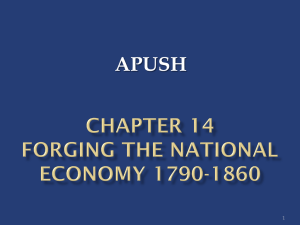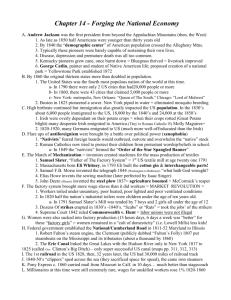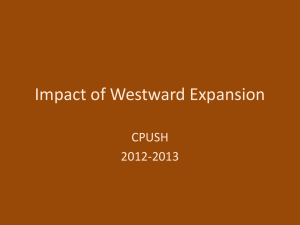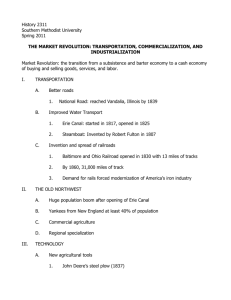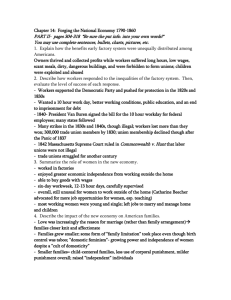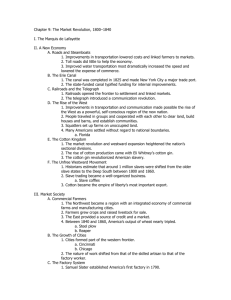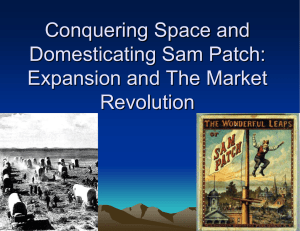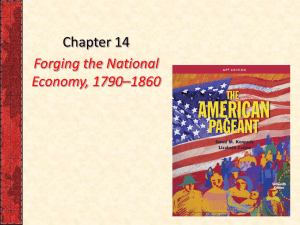Movement of People
advertisement
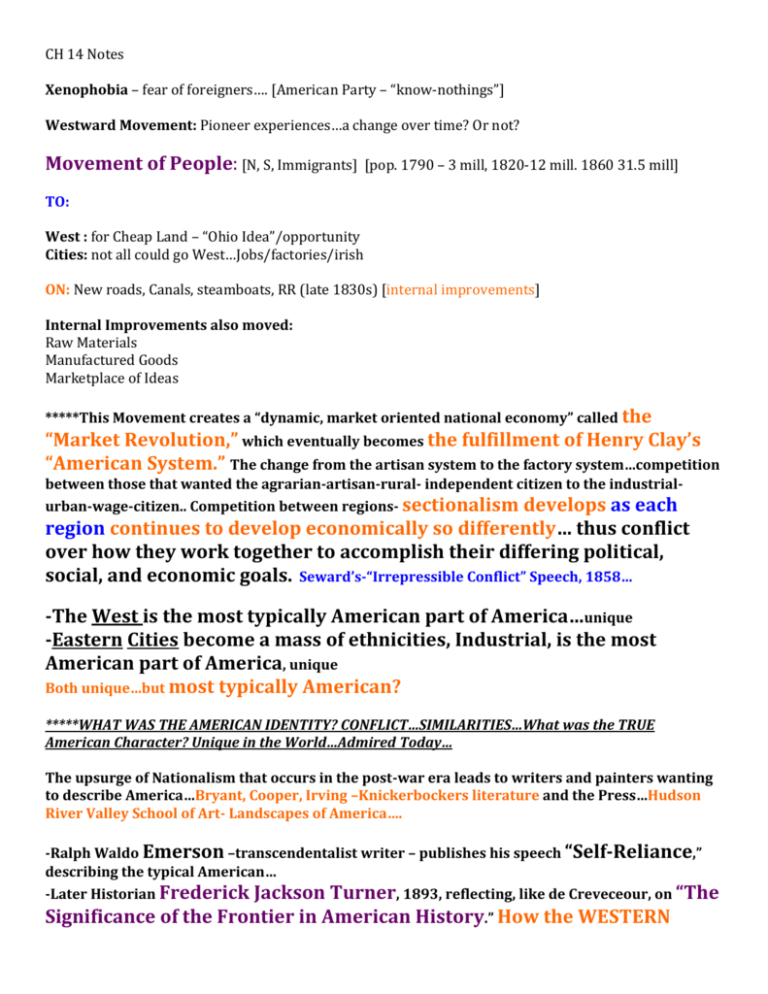
CH 14 Notes
Xenophobia – fear of foreigners…. [American Party – “know-nothings”]
Westward Movement: Pioneer experiences…a change over time? Or not?
Movement of People: [N, S, Immigrants]
[pop. 1790 – 3 mill, 1820-12 mill. 1860 31.5 mill]
TO:
West : for Cheap Land – “Ohio Idea”/opportunity
Cities: not all could go West…Jobs/factories/irish
ON: New roads, Canals, steamboats, RR (late 1830s) [internal improvements]
Internal Improvements also moved:
Raw Materials
Manufactured Goods
Marketplace of Ideas
*****This Movement creates a “dynamic, market oriented national economy” called the
“Market Revolution,” which eventually becomes the fulfillment of Henry Clay’s
“American System.” The change from the artisan system to the factory system…competition
between those that wanted the agrarian-artisan-rural- independent citizen to the industrialurban-wage-citizen.. Competition between regions- sectionalism develops as each
region continues to develop economically so differently… thus conflict
over how they work together to accomplish their differing political,
social, and economic goals. Seward’s-“Irrepressible Conflict” Speech, 1858…
-The West is the most typically American part of America…unique
-Eastern Cities become a mass of ethnicities, Industrial, is the most
American part of America, unique
Both unique…but most typically American?
*****WHAT WAS THE AMERICAN IDENTITY? CONFLICT…SIMILARITIES…What was the TRUE
American Character? Unique in the World…Admired Today…
The upsurge of Nationalism that occurs in the post-war era leads to writers and painters wanting
to describe America…Bryant, Cooper, Irving –Knickerbockers literature and the Press…Hudson
River Valley School of Art- Landscapes of America….
-Ralph Waldo Emerson –transcendentalist writer – publishes his speech “Self-Reliance,”
describing the typical American…
-Later Historian Frederick Jackson Turner, 1893, reflecting, like de Creveceour, on “The
Significance of the Frontier in American History.” How the WESTERN
experience was critical to the development of democratic traditions and
creating a unique American…different from Europeans…coming here (the
pioneer experience) transformed them….
Americans:
1 Young – by 1850 avg age under 30
2 Tough – backbreaking labor in the fields or in the factory
3 Independent – Self-reliant, Isolated
4 Provincial – supported small towns – or their specific regions
5 Common – survival 1st priority, education a luxury
6 Neighborly – barn raising, urban groupings based on ethnicity
7 Govt Support – Law & Internal Improvements (esp. North and West)
8 Wild- the people were like the “land-city” they tame…
Expansion West:
“Manifest Destiny,” Many at this time viewed our
expansion as necessary to achieve America’s “Destiny” and protect American
interests. The “Ante-bellum” period saw the quasi-religious call to
“spread democracy” coupled with the reality of thousands of settlers
pressing westward—These pioneers were spreading AMERICAN GREATNESS—“The
City Upon a Hill” moving WEST.
1- Americans believed that the strength of American Values and
institutions justified moral claims to hemispheric leadership.
2-The lands on the North American continent west of the Mississippi River
(and later into the Caribbean) were “DESTINED” for political and
agricultural IMPROVEMENT led by the American example.
3- Americans who supported expansion believed that GOD and the CONSTIUTION
(political perfection) ordained an irrepressible destiny to accomplish
redemption and DEMOCRATIZATION THROUGHOUT THE WORLD.
Columbia, the female figure of America, leads Americans into the West and into the future by
carrying the values of republicanism and progress and clearing native peoples and animals, seen
being pushed into the darkness to open the way for our “yearly multiplying millions to
overspread the continent of our MANIFEST DESTINY.”
“AMERICAN EXCEPTIONALISM”
The “Young America Movement” downplayed divisions over slavery
and ethnicity by EMBRACING; National Unity, American Exceptionalism,
territorial expansion, democratic participation, and economic
interdependence.
“In every age of the world, there has been a leading nation, one of a
more generous sentiment, whose eminent citizens were willing to stand for
the interests of general justice and humanity, at the risk of being
called, by the men of the moment, dreamers. Which should be that nation
but these States? Which should lead that movement? Who should lead the
leaders but the YOUNG AMERICAN?” Ralph Waldo Emerson, 1844, “The Young
American” speech
Conservation movement begins due to the PIONEER experiences…
George Caitlin’s paintings, Cooper’s books, preserve the wilderness for later generations… 1872
Yellowstone 1st National Park…Beaver, Bison, Otter disappearing…Ecological Imperialism…
Immigration********& Growth
Growth
-Population in 1790 3.9 million by 1860 31.5 million
-By 1860 33 states, 4th most populous country in the Western World
- 43 Cities over 20,000 in pop. [rapid urban growth] – [Political Machines- Tammany Hall
in NYC] (only 2 in 1790)
Problems with Rapid Urban Growth:
Slums, Crime, Inadequate policing-gangs, Political Machines, Impure Water, Garbage
disposal… (boston – 1823 1st sewer system) (NYC 1842- piped in Water to city-reservoir
system)
“OLD” Immigration 1815 (end of War of 1812) – 1861 (civil war)
**Huge in the 1840s and 50s
1840’s Immigration Triples… 1850’s Quadrupled [Most from Ireland and Germany 9 million 1830-1900]
liberal revolutions fail…food crops fail…
Why come to the USA?
1 Europe closed (pop 2x, 60million left Europe 1840-1940)
2 Freedom – no aristocracy, no “state church,” no mandatory military service
3 Cheap Land
4 Low taxes
5 Opportunity***jobs***industrial growth
6 reduced time and cost to travel - transatlantic steamers reduce time from 10 weeks to 12 days..
7 America letters – written by those already here to those in the old country
8 Corporate advertising for workers…
Irish
1830 -1860 4 million…1840’s potato famine….stay in cities-no $ to go west…
Poorer, less educated, formed own schools, settled in eastern cities
young, literate in english, ROMAN CATHOLIC, survived by forming political alliances and voting in blocks
–traded votes for jobs, food, protection…Dem. Party…policemen, firemen, building inspectors,
etc……[political machines-boss system-Tammany hall in NYC] In other employment…not govt controlled
were discriminated against NINA…resented free blacks and other ethnicities due to competition for
lowest paying jobs…
Germans
1830- 1900 5 million…largest group…collapse of German liberal democratic revolution in 1848… most
moved to mid-west (Wisconsin, Missouri, Texas) established tight communities…religious, too…Jewish,
Catholic, and others in Penn. Ohio Indiana…Amish… also banded together and voted in communities…
Educated, some $, protestant and Catholic….HATED SLAVERY… brought BEER, X-mas Trees,
Kindergarten, Wagons, long rifle….Milwaukee-“Athens of the West,” St. Louis, Mo., Fredericksburg, Texas.
Nativism-xenophobia*********[movie: Gangs of NY***) great example of
Political Machines, Immigrant conditions in growing Urban Cities,
Nativism in practice---Competition for resources….lasts well into the 20th
Century through the New Immigration period from 1880s to 1920s.
Anti-Catholic riots, mass violence, discriminatory laws, competition for jobs…living space-esp. in growing
urban areas…
Fear that Immigrants would “outbreed, outvote, & overwhelm- the native
people
Rise of Catholicism- 1840 4th largest denomination, by 1850 1st-largest, still today.
Natives form APA – American Protective Association & American “know-nothing”
Party (secret)
We become the most diverse nation in the world and their spirit of
survival fuels America to become the #1 industrial nation in the World by
1900.
THE INDUSTRIAL REVOLUTION STARTS WITH STEAM ENGINES…IN
GB
-Multiplied the power of humans by 10000 X…The Focus is
making Cotton Textiles,
cloth
REVOLUTIONS ALSO OCCUR IN:
Agriculture:
John Deer’s Steel Plow in 1837 …stronger and lighter than iron…
Cyrus McCormick’s REAPER…can do the work of 5 men
These machines cost $$$ forces farmers to become agribusinessmen…
Eli Whitney’s Cotton Gin 50 X more Productive
Interchangeable Parts
Whitney’s two inventions 1793 & 1798 transforms America….Cotton’s boom leads to many
consequences….and interchangeable parts allows for factories to use the assembly line….
Transportation: [Canal Era 1820s and 30s] {RRs 1840s to 1920s]
Roads…Lancaster Turnpike 1790’s 62 miles from Lancaster to Philly…National Road –Cumberland Road
begun in 1811…591 miles Baltimore to Illinois…
Canal Systems: Erie Canal 1825 …connected the Great Lakes to the Atlantic Ocean, by 1860 over 1000
canals…
Steamboats: Robert Fulton, “Clermont”, Fulton’s Folly 1st in USA eventually takes over all major rivers
HUGE… up stream…on time….
Clipper Ships: opened up Asian trade…short life… very fast…Tramp Steamers eventually take their place
…can carry more…
Railroads: 1st in 1828, by 1860- 30,000 miles of track…Most important improvement in developing
the national economy or fulfilling the Market Revolution. Initially RR’s slow and dangerous and
opposed by canal backers.…traveled on different gauges of track…had to buy many tickets to go very far…
by 1860 3/4ths of the track were in the north…by 1862 the Pacific Railway
Act…begins the transcontinental railroad… passed
during the Civil War (Southerners
not in Congress or in control of the Presidency to VETO), by Lincoln,
fulfilling Clay’s “American System,” THE LARGEST SINGLE UNIFIED MARKET IN
THE WORLD….
Communication:
Samuel F. B. Morse invents the Telegraph in 1844…lines are stretched at the same time that rr tracks
are lain…. “Instant Communication” – news, Diplomacy, finance…
Cyrus Field – Laid a cable across the Atlantic ocean.. Trans-Atlantic communication…Am- Europe 1860’s
WHAT TOOK AMERICA SO LONG TO INDUSTRIALIZE???
1 BRITISH SECRECY – Samuel Slater, father of the American Factory System – In 1791 he escapes to
America, in disguise, and builds the 1st textile machine FROM MEMORY…helps to build the 1st factory…
2 CHEAP LAND – LABOR SCARCE … why work in a factory when you can own your own land ….
Immigration booming in 1840’s and 50’s leads to a huge increase in factory production…
3 little or no CAPITAL $ for investment….
4 Consumers scarce…(urban cities and transportation…slowly develops)
5 Raw materials scarce….until transportation develops
THE CHANGE OCCURS….A REVOLUTION… HAMILTON’S DREAM….
1>-1ST INDUSTRIAL REVOLUTION BEGINS DUE TO (embargo, non-importation, macon’s & war
until 1815)
2>-1st IR – is based on making Cotton Cloth…TEXTILES…BEGINS THE CHANGE….
3>-SAMUEL SLATER IS HUGE….1791…”Father of the American Factory System”
4>-ELI WHITNEY 1793 COTTON GIN / 1798 INTERCHANGEABLE PARTS (GUNS FIRST)
5>- ELIAS HOWE AND ISAAC SINGER – SEWING MACHINE…1846…READY MADE CLOTHING
INDUSTRY…SIZES STANDARDIZED DURING THE CIVIL WAR FOR
UNIFORMS… 25 STITCHES PER MINUTE… EVERYTHING HAS STITCHES….
6> 1ST FREE INCORPORATION IN NYC (thank you locofocoists), limited liability, Public stock
trading… 1848 in NY
7 >Boston Associates, 1st mega corporation…in textile mills…”the Lowell System”****huge….
“Lords of the Loom will be tied to the Lords of the
Lash”******** Slavery and Industrial Growth, worldwide, are tied
together…as the “Cotton Kingdom expands…so to does “Capitalism”
worldwide….Britain, France, and our US Industrial Systems are
dependent on Cotton Grown in the New Southlands…The population
of Slaves grows from 2.4 Million in 1820 to over 4 million by
1860… Banks finance; New Farms, Slave Purchases, Factories, and
insurance companies insure all of this… Our incredible growth is
indelibly tied to the Slave System… as a
NATION.******************
EFFECT: the American system a reality?
North: favors industrialization, immigrant labor (free wage labor)
South: favors agriculture (cotton) , slave labor
West: Mix ag-ind., Great lakes ports transform mid-west, artificial links, Canals & RR’s, to
North…changes dynamic of country… Buffalo, Chicago, Detroit, Cleveland…
WHY NORTH /NE FAVORED AS INDUSTRIAL CENTER?
- Farming too difficult/dense pop./ no slave labor
- rapid rivers provide a early power source for “steam” engines
- Seaports – access to get raw materials
- markets- (pop) shipping provided Capital $$$
Ex: Lowell Mills****…in Mass. * girls come off the farms, live in dormitories chaperoned by older
women, work 80 hrs a week…Sunday Church…”Lowell System”…become 1st strikers, forming labor
unions by 1820’s… in Mass. wins 1st case to allow for unions
nationwide…Commonwealth v. Hunt, 1840…. only state to make labor unions legal
at the time. Labor Unions to come after the Civil War in a big way.
End Part 1

